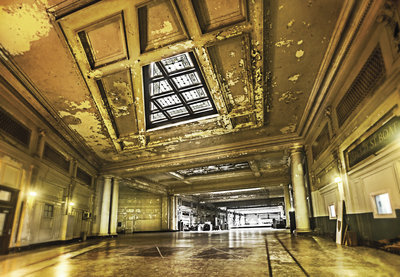In the 20th century, before the Holland Tunnel and the PATH trains dominated trans-Hudson travel, ferries ruled, and the architectural grandeur of the Erie Lackawanna Terminal is proof. Today, large sections of the terminal are long abandoned. Though the paint is chipped and the floors are dusty, their sheer majesty remains.
Thousands of commuters pass through Hoboken Terminal every day. For a long time, I was one of them. I’d walk from the light rail station on the south end, past the 17 train tracks of New Jersey Transit, stairwells leading to the PATH, and out onto River Street. For most people, in 2013, those are the elements that make up “Hoboken Terminal.”
But that’s a relatively new way of thinking about it. For a long time it was the Erie Lackawanna Railroad and Ferry Terminal. As you walk along the river toward the terminal, you can’t help but wonder what’s in all those areas closed off to the public, and what’s up in the balcony overlooking the newly refurbished ferry slips.
Recently, I got a chance to tour sections of the terminal that were closed off to the public years ago, including the gargantuan old ferry terminal waiting room and some of the old ticketing rooms. Bill Smith, a senior spokesman for NJ Transit, was my guide, and told me that in the mid-20th century, the terminal saw about twice as much traffic as it does today. The majority of those people took the ferry, which makes sense, though today ferries are the odd man out.
What we now think of as Hoboken Terminal is really just a small sliver of the entire structure, and much of it, like the PATH and the light rail, are additions.
The old terminal’s main concourse, directly above and behind the New Jersey Transit waiting room, looks to be the length of two football fields with ceilings that are easily 50 feet tall. There are three sets of enormous skylights—one has the original stained glass—and remnants of chandeliers that hung from above. The floor, covered in a layer of thick dust, is a geometric mosaic of myriad small tiles.
The gorgeous masonry is in chunks, many of the windows are broken, and the intricate molding is damaged. But the place has a beautiful vagrant feel that might be lost in a restoration, no matter how faithful that restoration might be.
In one sense, the waiting room is already a restoration. Built in 1907, today’s terminal, officially called the Erie Lackawanna Railroad and Ferry Terminal by the New Jersey and National Register of Historic Places, replaced one that burned to the ground between Aug. 8 and 10, 1905. The fire also claimed two ferries and the famous Duke’s House tavern and restaurant. The 1907 terminal was built with more fire-resistant materials. In rebuilding the terminal, the people at the Delaware, Lackawanna & Western Railroad Company, which owned the site, made it stronger and more stunning than its weaker predecessor, with molded copper decorations, Tiffany skylights, and a gilded clock.
Like many of the transportation hubs built around the same time, such as Grand Central Terminal across the river, it was designed in the Beaux-arts style synonymous with 19th century Paris. And that’s not the terminal’s only French connection. Its bronze facade is clothed in the same copper used on the Statue of Liberty.
The train station’s waiting room, which has been majestically renovated, transports you to another era. In fact, parts of Julie and Julia were shot here, with Meryl Streep and Jane Lynch waiting in their 1940s outfits for a train to come in.
On the eastern side of the concourse, you can step out on the balcony above the terminal’s original ferry slips and watch thousands of ferry riders on their rush-hour commute. Ferry service was suspended sometime in the mid-20th century, and while service was restored in 1989, these original slips didn’t reopen until 2011, the first time in recent history that the old and new sections of the terminal were in operation at the same time.
You have to wonder what the future of the concourse will be. It’s too spectacular a treasure to ignore, but plans are still in the idea phase. John Leon, NJ Transit’s senior director for government and community relations, has said there’s been discussion about using it as a community space in conjunction with NJT’s massive Observer Highway Redevelopment Plan. But the plan isn’t finalized and talks with the city are ongoing.
New York City has its abandoned but beautifully adorned subway stations. Detroit has entire neighborhoods of forgotten theaters and hotels. Hoboken Terminal is in better shape than these. But it will take a massive restoration to return it to its former glory.—07030
PHOTOS BY Terri Saulino Bish
